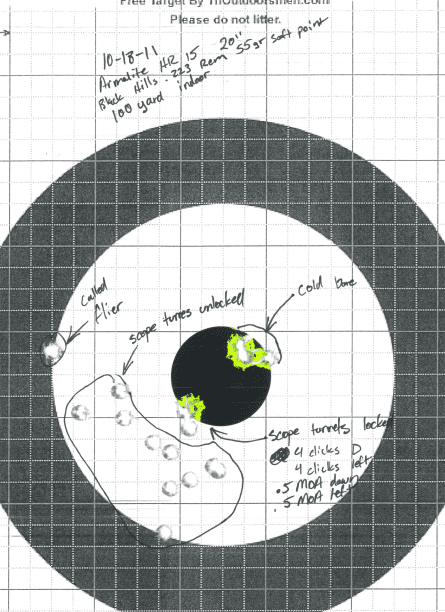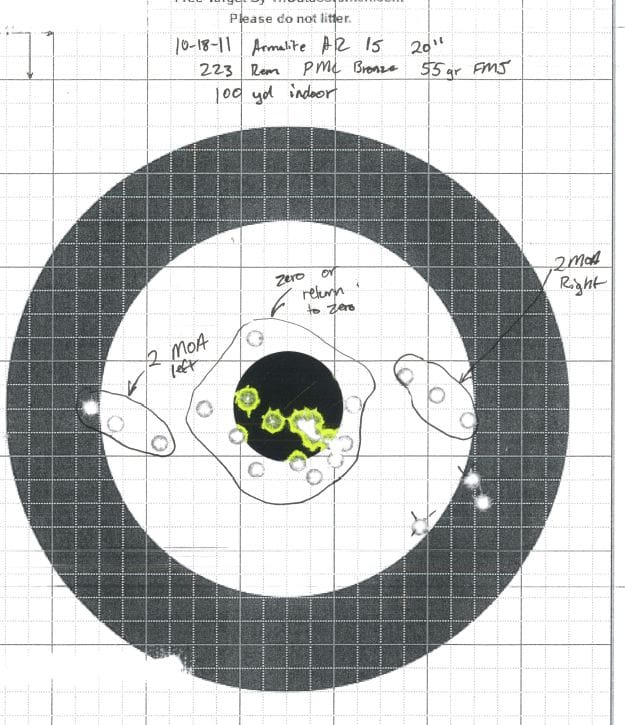 There are days when I’m extremely pleased to have an understanding fiancée. Specifically, the day I ordered a few hundred rounds of Black Hills ammo for my AR. For most of her life, my AR has been fed a constant diet of 55 gr PMC Bronze FMJ ammo. However, I got the old girl hooked on some Black Hills 55 gr. softpoints a while back, and now she’s become a bit picky. As you may or may not know, the BH ammo is just a touch pricier than run of the mill PMC Bronze. But the Black Hills stuff seems to shoot a lot better than the PMC, and when doing scope testing I like to eliminate as many variables as possible . . .
There are days when I’m extremely pleased to have an understanding fiancée. Specifically, the day I ordered a few hundred rounds of Black Hills ammo for my AR. For most of her life, my AR has been fed a constant diet of 55 gr PMC Bronze FMJ ammo. However, I got the old girl hooked on some Black Hills 55 gr. softpoints a while back, and now she’s become a bit picky. As you may or may not know, the BH ammo is just a touch pricier than run of the mill PMC Bronze. But the Black Hills stuff seems to shoot a lot better than the PMC, and when doing scope testing I like to eliminate as many variables as possible . . .
Long story short, the Konus M30 was a waste of good ammo. It is on the way back to the fine folks who sent it over to me. Maybe they’ll send me a new one, maybe they won’t. I haven’t heard back from the email with a tracking number that I sent a few days back. Before I reveal the dirty details on what exactly went down, I want to run through my testing protocol.
Test #1 Does it hold Zero?
For those of us that have a load we use, and sight our guns for a known distance, holding zero is the only important thing to worry about. Use a bit of Kentucky windage or the MPBR method and you are good to go.
Test #2 Do the “clicks” correspond?
When Kentucky windage just won’t do, a shooter needs to know that adjustments made for elevation or windage will reliably correspond to Point of Impact changes downrange. My test is very simple. Establish a zero. Move the turret two MOA to the left, shoot at least three (ideally five) and return the turret to the established zero. Shoot at least three. Do the same for right, up, down. At 100 yards, your target should have three to five holes approximately two inches to the left, right, top, and bottom of one large ragged hole at your zero.
Test #3 If it has dots, what do they mean?
For those scopes that have a mil dot reticle, it’s important to know that “dots” actually correspond to some system of measurement. Typically, this will just mean cycling the scope through magnification settings at known ranges and known target sizes. In my case, my indoor range is 100 yards and I use grid paper with minor gridlines at .25” intervals and major gridlines at 1” intervals.
Beyond those tests, I usually look for basic functionality, quality of craftsmanship, and ease of use. Here is how it broke out.
Test #1 Our protagonist is pleased
I had zero issues with the M30 holding zero. Once it was dialed in with the turrets locked, it would hold zero all day long. If I were just going to leave it like that forever, I think the M30 would be a fine scope. FYI, without the turrets locked, my shots were all over the place. In the image below, I shot three to establish zero (I told you my AR liked the BH ammo), moved the turrets 4 clicks down and 4 clicks left, and started shooting.
However, I left my turrets unlocked and watched ten or so shots wander all around the lower left quadrant of my target. Once I locked my turrets, I was able to put three holes about one inch low and one inch left.
Test #2 Our Protagonist sets money on fire and uses foul language
Due to the M30’s 1/8 MOA adjustments, illuminated reticle, parallax adjustment, and 16X magnifications, this is not a “set it and forget it” scope. This is why the second test was so vitally important and exposed some major flaws. The good news was that the M30 did a fairly good job in the horizontal axis.
As you can see here, I have a close approximation of my ideal target. Most of my shots are near the bull and there are three shot groupings to the left and right. However, those three shots groups were only a bit more than an inch from the center. I specifically ordered up two MOA left and right, and was a bit disappointed to not see my shots move further from the center. Please forgive the less-than-tight groupings. This is what my AR does with the PMC stuff. I had foolishly run out of Black Hills.
Hopefully, you can follow the flow chart shown here on my target. Things were going OK until I returned my turrets to zero and watched my shots start hitting an inch below my point of aim. This happened on at least three separate targets. This one just happened to be the most photogenic
Final Issues
I wanted to make sure this wasn’t a one-time occurrence. Until I build my Siri powered scope testing robot, I’m still a fallible human being. As such, I ordered a few hundred rounds of BH .223 REM ammo and went back to the range with a fresh package of graph paper to start my test from scratch. I got five rounds into my test when the illuminated reticle started flickering on and off with each shot. That was the final nail in the coffin. I shot all of ten shots with the M30 during my second round of testing before I removed it at the range and replaced it with my Leupold Rifleman. At which point I delighted in finding out that 60 gr. VMax Black Hills loads are my new favorite for my AR. As I told Mr. Zimmerman, time spent with your finger on the trigger is not deducted from your life.
The M30 was an overall disappointment, and I would highly recommend against purchasing one. You would be much better off to sacrifice features for build quality and solid results.







You would be much better off to sacrifice features for build quality and solid results.
Tyler, no truer words have even been spoken. This has been one of Ralph’s Rules for about a million years and applies to just about every piece of equipment a human being might purchase. Another one of Ralph’s Rules is: it’s dear to buy cheap. At around $300 street price, the Konus can’t be considered cheap, but when compared with other scopes with similar features, it is.
I should mention that Konus received the defective scope and has promised that this was a one time thing and that they’ll be sending me a new M30 to test.
Thanks for being the guinea pig on this.
I don’t know about their rifle scopes, but I do astronomy and the Konus telescopes and mounts are weak beer. It’s stuff for beginners and kids. You want precision gear, look elsewhere, even starting at their price point.
Comments are closed.